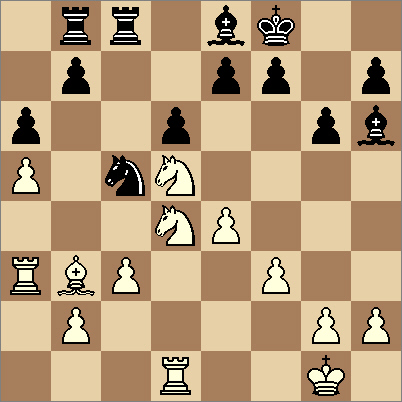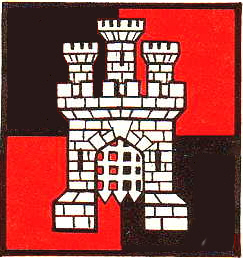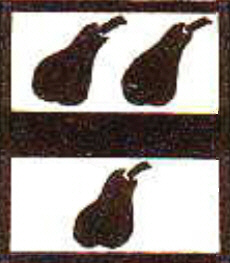Steve Mellor Wins Knock Out Final
Jim Keene - Steve Mellor
Worcester City Chess Club KO Final, 27 May 2010
This was a splendid strategic game where black exploited white's weak queenside pawns, causing white's pieces to get into a tangle. Steve Mellor won the exchange - rook for a bishop - but black still had defensive resources and Jim Keene might have been able to draw the game because his knights were well posted.
1.e4 g6 2.d4 Bg7 3.Nf3 d6
This is the Modern Defence where black attacks white's central pawns from the flank.
4.Bc4 Nf6 5.Qe2 0-0 6.0-0 Nbd7?!
Black can also play: a) 6...c6 7.Bb3 a5 8.a4 Na6 9.Bg5 h6 10.Bh4 g5 11.Bg3 Nh5 12.c3 Nc7 13.Nbd2 Ne6 14.Ne1 Nhf4 15.Bxf4 Nxf4 with a balanced and complex middle game (Jansa-Ciocaltea, 1971, Wijk Aan Zee) or b) 6...Bg4 7.Nbd2 Nc6 8.c3 e5 9.h3 (Shamkovich-Bronstein, 1972 Baku) when 9...bxf3 is possibly best.
7.Nc3
7.e5 may be stronger: 7...dxe5 8.dxe5 Ng4
7...c5
this move ntensifies the thematic flank attack on white's centre.
8.Be3
More adventurous is: 8.e5!? Ne8 9.e6 fxe6 10.Ng5
8...Ng4
The powerful fianchettoed bishop is unmasked to achieve equality.
9.Rfd1 Nxe3 10.Qxe3 cxd4 11.Nxd4 Ne5 12.Bd5 Ng4 13.Qf3 Qb6 14.Nce2 Bd7
14...Nf6 is worth considering here and on black's next move.
15.a4 Rac8 16.Ra3 Rc7
The pawn grab is worse: 16...Qxb2? 17.Rb3 Ne5 18.Qg3 Qa2 when white can win the exchange for a pawn with 19.Nc3 or proably better play Rb4 19.Rb4 Nc4 20.Qd3 when a piece will be lost for a pawn.
17.Qb3
Possibly better is 17.a5 Qa6 18.Nc3 Ne5 19.Qe3 Rfc8 with equality
17...Qxb3 18.Bxb3 a6 19.Nc3 Nf6 20.a5 Rfc8 21.f3 Kf8 22.Na4 Be8 23.Nb6 Rb8 24.Rd3
24.c3 to protect the b2 pawn on the long black diagonal and take the pressure off c2 may be a good alternative.
24...Nd7 25.Nd5 Rcc8 26.c3 Nc5
26...b6 27.axb6 e6 wins back the pawn and black's pieces are better co-ordinated.

|
Keene - Mellor, white to move
Position after 24...Nc5 |
27.Rd2 Bh6 28.Rd1
Possibly better was 28.Re2 e5 29.Nc2 Nxb3 30.Rxb3 Bb5 31.Rxb5 axb5 32.Ncb4 reaches a position where black's material advantage is counterbalanced by white's securely posted knights.
28...Nxb3
28...e5 looks more convincing 29.Nc2 Nxb3 30.Rxb3 Ba4 when black picks up the exchange.
29.Rxb3?
29.Nxb3 e6 30.Nb4 is a better continuation for white
29...Ba4 30.Kf2 Bg7!
Better than taking the rook immediately and showing that white should have kept his king on the first rank.
31.Rd3 Bxb3 32.Nxb3 Ke8 33.Nb6 Rc6 34.Ke2 Rd8 35.Kd1 h5 36.h3 Be5 37.Kc2 e6 38.c4 Ke7 39.Nc1
39.Nd4 was a more active defence.
39...f5
forcing an opening on the king side to use his long-range pieces more freely.
40.b3 Rf8
Another plan is to play 40...Bg3 threatening to win the unprotected pawn on a5.
41.Rd2 Bf4 42.Re2 fxe4 43.Rxe4 Rf5 44.b4?
Better is 44.Ne2 Be5 45.Kd3 Kf7
44...Bxc1 45.Kxc1 Re5
45...d5! exploits the pin on the c-file 46.Re3 dxc4 to bag an extra pawn.
46.Rxe5 dxe5

